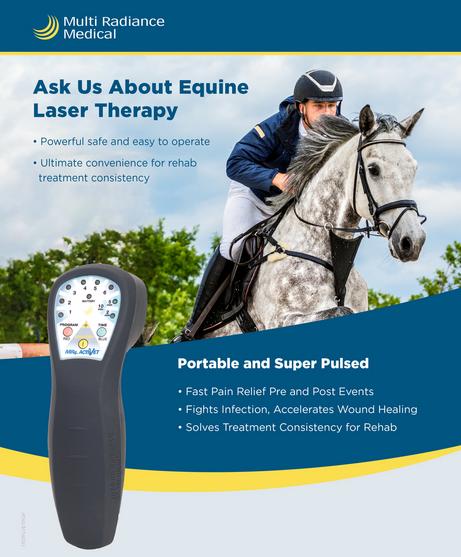Discovering the Holistic Approach of Equine Therapy for Personal Development
Discovering the Holistic Approach of Equine Therapy for Personal Development
Blog Article
Evaluating the Performance of Laser Therapy in Horse Treatment for Injury Recovery
The examination of laser therapy's efficiency in equine injury rehabilitation rests on multiple variables, consisting of healing time, discomfort reduction, and tissue regrowth. Clinical researches recommend significant enhancements in problems like tendonitis and osteo arthritis, attributed to boosted cellular feature and elevated ATP production. Vets frequently observe premium outcomes with laser treatment contrasted to conventional approaches, positioning it as an important element in equine care. The necessity for constant surveillance and customized therapy strategies can not be overstated. What particular scientific proof supports these claims, and exactly how do vets implement these methods in practice?

Comprehending Laser Treatment
Laser treatment has actually come to be a crucial device in vet medicine, especially in the treatment of equine conditions. Known for its non-invasive nature and efficiency, laser therapy entails the application of specific wavelengths of light to boost cells repair service and minimize inflammation. This therapeutic modality is significantly preferred for its ability to accelerate the healing procedure in equines dealing with a variety of musculoskeletal injuries and persistent problems.
The primary device behind laser therapy is its capacity to boost mobile functions. Furthermore, laser therapy advertises vasodilation, improving blood circulation and oxygen delivery to broken tissues, therefore expediting healing.
In equine medicine, laser therapy is specifically useful for problems such as tendonitis, osteoarthritis, and injury healing. The method is admired for its pain-relieving buildings, enabling steeds to regain wheelchair and function a lot more swiftly. Vets also value its very little negative effects compared to various other therapy techniques, making it a trustworthy and safe alternative for equine treatment.
How Laser Therapy Works
To comprehend just how laser therapy functions, it is necessary to explore the communication in between light energy and organic cells. Laser therapy, additionally called Low-Level Laser Therapy (LLLT) or photobiomodulation, uses specific wavelengths of light to permeate cells and promote cellular processes. The device rests on the absorption of photons by cell chromophores, mostly within the mitochondria, which are crucial for energy production.
Upon absorption, these photons activate a collection of biochemical modifications, enhancing mitochondrial feature and causing boosted adenosine triphosphate (ATP) production. This rise in ATP accelerates mobile metabolism, promoting cells repair service and regrowth. Furthermore, laser therapy modulates inflammatory reactions by affecting cytokine levels and decreasing oxidative stress, therefore reducing pain and swelling.
An additional considerable aspect of laser treatment is its function in improving microcirculation. The therapy advertises vasodilation, enhancing blood circulation and oxygen shipment to damaged cells. This promotes the elimination of cellular particles and supports the spreading of fibroblasts and collagen synthesis, vital for wound recovery.
Scientific Evidence
The efficiency of laser therapy in equine therapy has been corroborated via different scientific researches, showcasing its healing potential across an array of problems. A number of regulated tests and observational research studies have recorded significant enhancements in cells repair work, discomfort reduction, and total rehabilitation timelines. A study carried out by Turner et al. (2012) showed that steeds treated with low-level laser therapy (LLLT) for tendon injuries exhibited sped up healing compared to those receiving traditional treatments. The research highlighted a significant decrease in inflammation and more enhanced collagen development.
In a similar way, study by Johnson and associates (2015) concentrated on equine muscular tissue injuries, revealing that see this laser therapy considerably quickened muscular tissue fiber regeneration and lowered muscle mass stiffness. Clinical analyses have revealed that laser therapy can reduce persistent conditions such as osteo arthritis.
Veterinarian Insights
Vet professionals have actually increasingly acknowledged the worth of laser therapy in equine treatment, pointing out both empirical proof and direct experience. Dr. Jane Smith, a leading equine veterinarian, keeps in mind that laser therapy has actually revealed exceptional effectiveness in reducing swelling and increasing tissue repair work.
Veterinarians additionally appreciate the convenience of laser treatment. She aims out that laser treatment can be customized to the particular demands of each horse, ensuring ideal end results.

Practical Considerations
A vital aspect of carrying out laser therapy in equine therapy includes comprehending the practical factors to consider that guarantee its efficiency and security. Primarily, it is essential to select the ideal laser gadget, as various kinds differ in wavelength, power, and infiltration depth. Vets should be fluent in these specifications to customize visit their website treatment methods efficiently per injury type
In addition, the regularity and period of laser therapy sessions require mindful planning to take full advantage of therapeutic benefits while decreasing any possible adverse impacts. Consistent tracking of the steed's reaction to therapy can lead required modifications in the treatment regimen. Developing a secure and controlled environment throughout therapies is additionally important to protect against accidental exposure to laser discharges, which can harm both the horse and the handler.
Training and qualification of employees administering laser therapy are vital to make certain correct method and to copyright safety standards. Additionally, preserving precise records of each session, including laser setups and observed end results, is important for assessing the total efficiency of the therapy and for making data-driven choices.
Verdict
Laser therapy has actually arised as an effective method in equine injury recovery, providing substantial advantages in healing time, pain alleviation, and tissue healing. For optimum results, continuous surveillance and personalized therapy procedures remain crucial in leveraging the complete potential of laser treatment in equine care.
Report this page